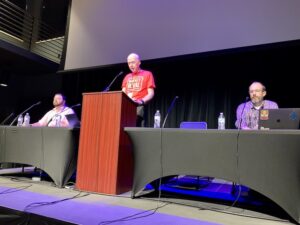 More than 50 journalists from around the country have already registered to speak at or attend Radically Rural, the two-day national summit featuring community journalism sessions. It takes place Sept. 27-28 in Keene, NH.
More than 50 journalists from around the country have already registered to speak at or attend Radically Rural, the two-day national summit featuring community journalism sessions. It takes place Sept. 27-28 in Keene, NH.
With a theme of “How did they do that?” two of the journalism sessions focus on news organizations that have built sustainability through various means, including philanthropic support, custom publishing, digital readership, and membership, while a third looks at some of the best journalism being produced at rural news organizations in the country, including Emmy- and Pulitzer prize-winning work.
Tickets are still available and for the first time, journalists can select from several price points, based on their ability to afford to attend, for as little as no charge up to the full summit price of $175. There are a limited number of free tickets.
“We want to make this as affordable as possible for journalists to attend, particularly those stressed by the challenging revenue markets facing their organizations and the cost of travel,” said organizer Terrence L. Williams, senior advisor for audience and community development for The Keene Sentinel. The Sentinel partners with the Hannah Grimes Center for Entrepreneurship each year to stage Radically Rural, which features solutions-based sessions for small communities on seven tracks – community journalism, land use, downtowns, healthcare, entrepreneurship, arts and culture, and clean energy.
This year’s event is in-person, Williams said. To register to attend or learn more about the programming, including track sessions for arts and culture, downtowns, clean energy, entrepreneurship, land use, and healthcare, go to www.radicallyrural.org.
Here’s this year’s community journalism program:
Sept. 27 I 11:00 a.m. to 12:30 p.m.
How’d they do that? Building sustainability: The demise of local journalism in rural America has received national attention, but in more places than you think, small news organizations are thriving. Our panel discussion will give you insights into how three news organizations have evolved their operations to secure a bright future.
Moderator – Williams
Panelists – Lindsey Young, co-owner, Kansas Publishing Ventures, publisher of Harvey County Now, The Clarion and The Hillsboro Free Press; Chris Baker, publisher, Taos News, Taos, N.M.; and Tristan Scott, managing editor, The Flathead Beacon, Kalispell, MT.
Sept. 27 I The Fourth Estate – 12:30 – 1:30 p.m.
Jeremiah Ariaz, professor of art at Louisiana State University, spent months in Kansas documenting in photography the state of more than 100 rural newspapers. In a moving, nostalgic presentation, he presents the fears and hopes for democracy in communities left without a newspaper or those clinging to what they have. Lunch provided. Attendance limited. Please register separately.
Sept. 27 I 2:00 p.m. – 3:30 p.m.
How’d they do that? Generating audience revenue: Successful rural news organizations are building revenue through fundraising, membership and paid readership. Our panel discussion unveils best practices among for-profit organizations and non-profits alike.
Moderator – Shay Totten, newsroom success manager, American Press Institute
Panelists – Arik Ligeti, director of audience, The Narwhal, non-profit online publication, Victoria, B.C., Canada; Christiaan Mader, founder/editor, The Current, Lafayette, La.; Carolina Guerrero, co-founder Radio Ambulante
Sept. 28 I 11 a.m. – 12:30 p.m.
How’d they do that? Groundbreaking journalism: A deep dive into how three organizations — from Mississippi to North Carolina to Maine — reported powerful stories that have deeply impacted the rural communities they cover.
Moderator – Jack Rooney, managing editor, audience development, The Keene Sentinel
Panelists: Victoria Bouloubasis, journalist, Emmy-award winning filmmaker, Durham, N.C.; Adam Ganucheau, editor-in-chief at the Pulitzer-prize winning Mississippi Today; Samantha Hogan, investigative reporter, The Maine Monitor, Augusta, ME.
